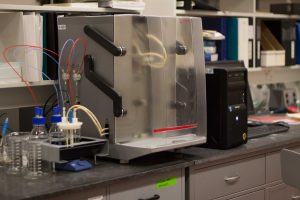 We use electrokinetic analysis to complement NLO methods and further our understanding of the electrical double layer (EDL) of silica/water. In the EDL, a negatively charged surface attracts hydrated counterions. These ions accumulate near the surface at the outer Helmholtz plane (OHP), and screen the negative surface charge.
We use electrokinetic analysis to complement NLO methods and further our understanding of the electrical double layer (EDL) of silica/water. In the EDL, a negatively charged surface attracts hydrated counterions. These ions accumulate near the surface at the outer Helmholtz plane (OHP), and screen the negative surface charge.

Water molecules between the surface and the OHP make up the Stern layer. While there is still a net negative charge beyond the OHP, albeit reduced by the presence of counterions, this generates a potential which can align the dipoles of water in what is referred to as the diffuse layer. This potential decreases exponentially with distance away from the surface, as ions in the diffuse layer screen more and more of the negatively charged surface. Using streaming potential measurements, we can measure the zeta potential (~ the potential at the outer Helmholtz plane) of the silica/water interface in the presence of different ionic species. Measuring the zeta potential should offer insight on relative cation adsorption. We are currently investigating trends in measured zeta potentials and their relation to trends observed in out SFG spectroscopy measurements.